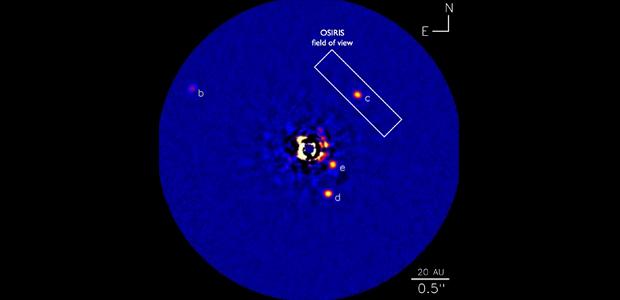Using the Keck-2 telescope, researchers have obtained high-resolution images of a jupiter-like planet’s atmospheric barcode and said it hints at how the planet – known technically as HR 8799c – was molded.
With laser-guided precision, a team of researchers from the United States and Canada have directly analyzed the atmospheric barcode of the Jupiter-like exoplanet, HR 8799c – orbiting its star, nearly 130 million light years away from our sun in the constellation, Pegasus.
Just out of the celestial oven – temperatures there may soar to as much as 925 C – the researchers said the glowing, gas giant’s brimming with water, carbon monoxide and clouds of dust.
“We can see specific things about its atmosphere because we know the light is coming from the planet and not from the star,” Quinn Konopacky, a postdoctoral researcher from the Dunlap Institute for Astronomy and Astrophysics at the University of Toronto, told SciFare.com.
That barcode may also explain how the mammoth planet – it’s roughly seven times heavier than Jupiter – was molded after its star was born, roughly 30 million years ago.
“[We can] say something about how the planet formed by comparing the predicted amounts of the elements from the formation models, to what we actually observe,” Konopacky said.
How the barcode compares to its star’s, also matters and one key component missing from HR 8799c’s was methane – the ratio of carbon monoxide and water was also different. The researchers said that may favour the evolution-like model of core accretion.
In the core accretion model, ice collisions in the debris field that surrounded its star eventually snow-balled to reach planetary proportions. A second growth phase, researchers said, included trapping gases that would allow it to reach its epic size.
It differs from the gravitational instability model – marked by a similar barcode in both the planet and its host star – that predicts the planet, essentially, formed in one giant step.
In addition to cool laser technology, a second innovation was necessary to decode its signature – known technically as an adaptive optics system.
OSIRIS – an acronym for OH-Suppressing Infra-Red Imaging Spectrograph – allowed the telescope to scan and analyze HR 8799c’s barcode in high-resolution, while simultaneously photographing it.
“At the same time you get a spectrum associated with every part of that picture,” she added.
While it may favour the model, researchers said it challenges the boundaries of it. Fortunately, the real challenge is to re-calibrate it with this new data – a challenge that may also help them understand how its entire solar system came together.
“In the traditional model, it was difficult to form planets this large, at these large distances,” Konopacky said. “If we can get the model to accurately predict the formation of these planets that could tell us more about the formation of planets, in general.”
HR 8799c orbits its star once every 190 years – it’s nearly as far away from its star, as Pluto is from the Sun – and core accretion is also the model researchers think led to the formation of the gas giants in our solar system too.
It’s also got some other planetary features found in our own celestial back yard – all of them super-sized, of course.
“The HR 8799 system looks like a scaled up version of our solar system,” Konopacky said. “We see these four large planets at relatively great distances from their star and two belts of material – one close in and one further out – kind of like we have in our own solar system.”
The first is an asteroid belt in front of its inner most gas giant while at its outermost planet, researchers see an oort-like cloud – an icy cloud that like ours, may define the boundary of its star’s grip.
It even leaves open the opportunity for other researchers to search for new planets between the star and the first gas giant – including an earth-like planet.
The research was published in the journal, Science Express.
 Science Fare Media Science News – Upgraded
Science Fare Media Science News – Upgraded




